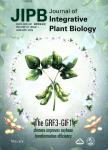Regulation of Arabidopsis Early Anther Development by Putative Cell-Cell Signaling Molecules and Transcriptional Regulators
Regulation of Arabidopsis Early Anther Development by Putative Cell-Cell Signaling Molecules and Transcriptional Regulators作者机构:Department of Biology and the Huck Institutes of the Life Sciences Pennsylvania State University University Park PA 16802 USA The Integrative Bioscience Graduate Program Pennsylvania State University University Park PA 16802 USA
出 版 物:《Journal of Integrative Plant Biology》 (植物学报(英文版))
年 卷 期:2007年第49卷第1期
页 面:60-68页
核心收录:
学科分类:09[农学] 0901[农学-作物学] 090102[农学-作物遗传育种]
基 金:Supported by a grant from the US Department of Energy and by funds from the Eberly College of Science the Department of Biology and the Huck Institutes of the Life Sciences at the Pennsylvania State University. Publication of this paper is supported by the National Natural Science Foundation of China (30624808) and Science Publication Foundation of the Chinese Academy of Sciences.This manuscript was largely based on a lecture given at Changsha in May 2006 and is not meant to be a comprehensive review of the field of anther and pollen development. We apologize for not including some of the recent works because of time constraints. We thank B. Bliss B. Feng Y. Hu A. Surce and A. Wijeratne for helpful comments on the manuscript
主 题:anther development Arabidopsis signaling tapetum transcription factor
摘 要:Anther development in flowering plants involves the formation of several cell types, including the tapetal and pollen mother cells. The use of genetic and molecular tools has led to the identification and characterization of genes that are critical for normal cell division and differentiation in Arabidopsis early anther development. We review here several recent studies on these genes, including the demonstration that the putative receptor protein kinases BAM1 and BAM2 together play essential roles in the control of early cell division and differentiation. In addition, we discuss the hypothesis that BAM1/2 may form a positive-negative feedback regulatory loop with a previously identified key regulator, SPOROCYTELESS (also called NOZZLE), to control the balance between sporogenous and somatic cell types in the anther. Furthermore, we summarize the isolation and functional analysis of the DYSFUNCTIONAL TAPETUM1 (DYT1) gene in promoting proper tapetal cell differentiation. Our finding that DYT1 encodes a putative transcription factor of the bHLH family, as well as relevant expression analyses, strongly supports a model that DYT1 serves as a critical link between upstream factors and downstream target genes that are critical for normal tapetum development and function. These studies, together with other recently published works, indicate that cell-cell communication and transcriptional control are key processes essential for cell fate specification in anther development.




